Just voted the #1 attraction in the world by Tripadvisor’s 2024 Traveler’s Choice Awards for Best of the Best, the iconic Empire State Building – built on the former site of the Waldorf Astoria hotel in midtown Manhattan in 1930-31, and the tallest skyscraper in the world until its soaring height was surpassed by the World Trade Center in 1970 (and following 9/11, again remained the tallest building in NYC until the construction of One World Trade Center in 2012) – is the subject of a new musical by Caroline Sherman and Robert Hull (book, music, and lyrics), in development since 1999, and now playing a revised Off-Broadway engagement at New World Stages, following a world-premiere run in La Mirada, CA, in 2016.

Directed by Cady Huffman, Empire: The Musical moves through three eras in NYC history – the Roaring Twenties (1929), the Great Depression (1930-31), and the American Bicentennial (1976) – imagining the people involved in the project, from the visionary industrialists who funded it, to the fearless Mohawk Skywalkers and melting pot of immigrants who, in a nod to Hamilton, “get the job done,” to the strained relationships of a daughter, wife, and granddaughter with connections to its construction. It’s all told using the central framing device of the adult daughter Sylvie (understudy Julia Louise Hosack was in for Jessica Ranville on the press date I attended), at stage right, going through the memorabilia her parents saved as she packs for a move, conjuring visions of their experiences, interacting with the figures of the past, finding a new understanding of their heroic dedication to making the lofty dream a reality, and thereby easing the familial tensions, in a musical tribute to “the men who go up when everyone is down.”
Interspersed with the invented personal stories are some real-life figures and fascinating historical facts about the monumental Art Deco building, including the background of the site, the extraordinary amount of construction materials that went into it, the changing plans to make it increasingly higher (with the final total of 102 stories), the design inspired in part by the shape of an upright pencil, the four and a half million pounds of pressure it can withstand, and the seemingly impossible feat of completing it within fourteen months (a mere 410 days) during a time of extreme financial crisis.

The uplifting two-act musical contains 23 original songs and a cast of seventeen, six seen in multiple roles, delivering the array of personalities, social classes, and ethnicities (from Mohawk to Italian, Polish, and Irish, with dialect coaching by Keri Safran), their dedication or opposition to the project, the period-style music (music supervision and orchestrations by Lena Gabrielle, arrangements by Robert Hull and Gabrielle, and music direction by Gillian Berkowitz) and high-energy dance numbers (exhilarating choreography, with lots of kicks, by Lorna Ventura), designed to shine a spotlight on the positive can-do attitude and pride in the achievement of creating a landmark of architectural history together, even if their individual names are forgotten and six of the workers would lose their lives on site.
A key player in the narrative, embodied with full-out chutzpah by Kaitlyn Davidson, is Frances Belle Wolodsky, or Wally, a composite character inspired by two real women from the ‘30s – Frances Perkins, a workers-rights advocate, Secretary of Labor from 1933-45, and the first woman to serve on a presidential cabinet during the FDR administration, who helped develop social security and the New Deal; and Belle Moskowitz, a Progressive reformer who worked as a political advisor and publicist to NY Governor and 1928 Democratic presidential candidate Al Smith – who takes charge of the press, orders the needed building materials, keeps the construction on schedule, rejects romance and marriage in favor of the career that drives her, and gives her all to advocating for the project in the face of challenges, complaints, and naysayers, while conveying her story of grit and determination to Sylvie, as expressed in the song “Wally Works/Never Say Never.”

Wally serves as the take-charge assistant to the male team behind the construction of the Empire State Building – the aforementioned Al Smith (former four-term Governor of New York, presidential candidate in 1928, and president of Empire State, Inc., the corporation that built and operated the skyscraper) and John J. Raskob (financial executive and businessman for DuPont and General Motors, chairman of the Democratic National Committee from 1928 to 1932, and a major supporter of Smith’s candidacy), joined here by the character Charles Kinney, an architect from the firm of Shreve, Lamb, and Harmon that designed the building and Wally’s jilted ex-fiancé (in a romantic sub-plot that reinforces her proto-feminist independence and self-esteem, noting, upon one of his demeaning sexist comments, that “the only coffee I carry is my own”). The trio of men – the excellent Paul Salvatoriello as Smith, Howard Kaye as Raskob, and Albert Guerzon as Charles – sing and dance in lively vintage form (replete with jazz hands) about the “Moxie” that’s needed, and they have, to accomplish one of the greatest architectural feats in history.
Providing the real heart of the compelling story are the devoted laborers – Ethan O’Dowd (portrayed by J Savage), Joe Pakulski (Devin Cortez), Paolo de Caprio (Ethan Saviet), Mateo Menzo (Robbie Serrano), Billy Betts (Joel Douglas), Jesse Bland (Danny Iktomi Bevins), the surprising Rudy Shaw (Kiana Kabeary, who doubles as Sylvie’s daughter Rayne, with plans, of which her mother does not approve, to become a construction worker), and foreman Abe Klayman (also played by Howard Kaye) – who moved from the “Heyday” of the Roaring Twenties to the breadline of the Depression to the heights of achievement, camaraderie, and danger while working on the building and completing it in record time. The group numbers – referencing the legendary photos taken by Lewis Hine during construction, of the actual men balancing on steel beams suspended in the air, high over the city – are performed with engaging vitality and perfect “Precision and Rhythm,” as also seen in “Lookahee,” “Don’t Look Down When You’re Going Up,” and “We’ll Work,” sending home the message that they’d “rather live a short life doing something than a long life doing nothing.”

Other featured characters are the Mohawk Grandmother, who speaks and chants in her indigenous language (performed by April Ortiz, also appearing as the Speakeasy Chanteuse singing “When To Say Whoa”), the Fifth Avenue Ladies, led by Mrs. Janet Arthur (the hilariously haughty Alexandra Frohlinger), who stand against the construction (which will bring in people other than wealthy socialites to their grand boulevard), want to “Protect What’s Mine,” and enlist the support of NYC Mayor Jimmy Walker (another role played by Cortez) with their money and influence. Rounding out the company are Morgan Cowling (as Emily O’Dowd, the wife of worker Ethan, who would prefer he not build “Castles in the Air,” as expressed in her powerful duet with Savage) and Joseph Fierberg and Kennedy Perez, members of the triple-threat ensemble.
The cast is accompanied by a live seven-piece orchestra (conductor Gillian Berkowitz and associate conductor Peter Leigh-Nilson on keyboards, Jeff Nichols on reeds, Clyde Daley on trumpet and flugelhorn, Szaz Rutkowski on cello, Sarah Favinger on bass, and Nicole Marcus on drums) capturing the styles and spirit of the eras, as do the character- and age-defining costumes by Tina McCartney and hair and make-up by Ian Joseph, from the flappers to the laborers to a joke about the ‘70s attire worn by Sylvie. The bi-level set by Walt Spangler, with props by Brendan McCann, serves as a variety of locales around NYC, with the steel beams of the skyscraper that move in and out and a window that moves up and down with the changing scenes (surprisingly, there are no background projections of views of the city from the worker’s towering perspective, though there is a joke about New Jersey), enhanced by Jamie Roderick’s lighting and sound by Shannon Slaton, which recreates the noise of the riveting (mimed by the actors) and the tragedy that concludes the first act.
If you love New York, its landmarks, and history, Empire: The Musical is an entertaining homage to the city, its diverse population, and its most famous building, incorporating factual information and some real-life figures into the original story, as told by and seen through the eyes of its two central women, Sylvie and Wally. And while some of the contrived romantic sub-plots lengthen the running time and distract from the theme of the monumental project, they also render the hard-working team responsible for its creation as more than just laborers and entrepreneurs, with distinctive backgrounds and personal lives, who were brave enough to take on the enormous challenge and make something for then and the future. That’s a contribution worth honoring and revisiting on the New York stage.
Running Time: Approximately two hours and 30 minutes, including an intermission.

Empire: The Musical plays through Sunday, September 22, 2024, at New World Stages, 340 West 50th Street, NYC. For tickets (priced at $58-144, including fees), go online.



